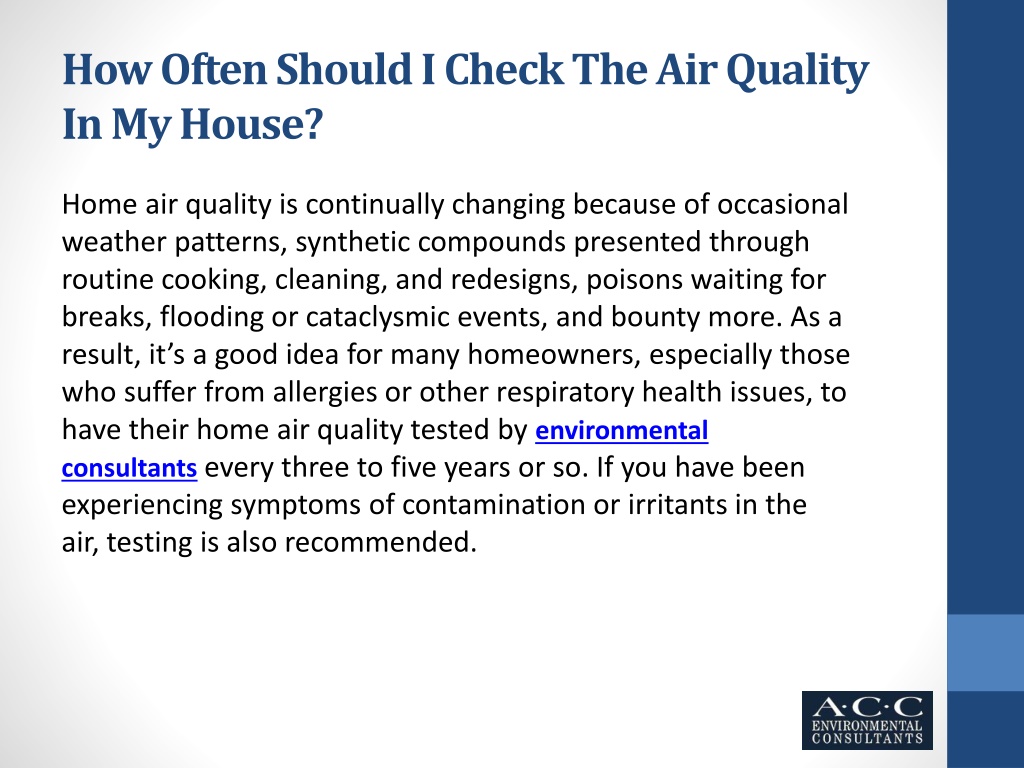Table Of Content

But Rohde recommended checking the air filter every month, even if it’s rated for 90 days. Every home is at risk of biological growth developing on their HVAC system over time, but Rohde said people who live in more humid environments have a higher susceptibility of encountering biological growth. Boothe’s Heating & Air sales manager John Winters said systems can provide an ideal environment for such organisms because of moisture and darkness. A home with a lot of carpet, pets or people also can contribute to the dirt or biological pollutants that accumulate in an HVAC, Winters said. At One Hour Air Conditioning and Heating, the standard price for a deep cleaning is usually $340 but could be lower if you’re a club member. Formaldehyde is a common volatile organic compound, or VOC — one of many harmful gasses sometimes emitted by common household items.
How Easy Is It to Use a Home Testing Kit?
At the very least, keep your doors and windows closed as much as you can. In the case of radon pollution, the EPA recommends sealing cracks in the foundation and installing vents and fans. Professional testing is often more accurate than DIY testing because professional tests take into account factors like temperature, humidity, and ventilation rate — all of which can affect IAQ. Professionals have access to more sophisticated equipment and can provide a detailed report of their findings. They may also be able to make recommendations for improving the air quality in your home.
Become a Lung Health Insider
It is widely regarded as one of the most harmful pollutants to human health for its prevalence at dangerous levels. Exposure to PM2.5 has been linked to health effects such as heart disease, respiratory illness, and premature death. To improve your indoor air quality, make your home smoke-free by banning all use of tobacco products indoors.
More Must-Reads From TIME
In many cases, especially where there has been a water intrusion or other catastrophe, it is very difficult for people to determine whether their home is safe without outside help. We spend most of our time indoors, and, as a result, our indoor air quality (IAQ) can have a significant impact on our health. Poor IAQ can cause several adverse health effects, such as respiratory problems, headaches, and fatigue. That’s why it’s important to test your home’s IAQ regularly and take steps to improve the air quality if necessary. The best indoor air quality monitors on the market can detect a variety of substances, including allergens, carbon dioxide, formaldehyde, ozone, mold spores, PM2.5, radon, VOCs, and more. Check your house for toxins by installing carbon monoxide detectors and a continuous air quality monitor.
Radon gas naturally occurs as a byproduct of the breakdown of the uranium found in certain rocks and soil. The gas can seep its way into a home through the foundation until it reaches harmful levels. Radon can enter your home through cracks in your floors, foundation, walls, or areas around pipes. Because radon gas forms from the breakdown of natural uranium deposits in the soil, it usually enters at the lowest levels of your home and concentrates there. You should schedule one of these tests if you believe for any reason you may have a mold issue but aren't sure since you haven't seen any.
Home air quality tests are worth it for the peace of mind they provide. You can address dangers that can lead to chronic health conditions by regularly testing your home’s air supply. Once you have a baseline understanding of your home’s air quality, take steps to improve it. Clean surfaces that host contaminants, take steps to improve ventilation, and alert professionals about unsafe living conditions.

Carbon monoxide
How — and when — to check indoor air quality in your home - The Washington Post
How — and when — to check indoor air quality in your home.
Posted: Sun, 17 Oct 2021 07:00:00 GMT [source]
This heavy metal was used extensively in older homes for piping as well as old layers of paint on walls, and can be harming people in your house without you knowing it. By finding out what toxins may be in your home, you can choose to install a better air filtration system or move forward with an abatement process that removes the harmful elements. Even if you aren’t experiencing any odd health related issues that you may think are related to your home, it is still a good idea to test the quality of your air. Not only is that process very costly, but it also takes a long period of time to go through a middle man like this. It used to be that in order to test the quality of your air, you would have to invest a good deal of money into hiring an expensive professional tester to come and take samples from all over your house.
Install Carbon Monoxide Detectors
For starters, a dehumidifier will help control the amount of humidity in the air, thus preventing mold and mildew growth. If the dehumidifier comes with air filters, it can help trap air pollutants such as dust, allergens, and more. Chemicals like VOCs can cause adverse health effects, so it’s important to reduce their levels as much as possible. One way to do this is by using natural cleaning products instead of chemical-based cleaners. The cost of professional testing will vary depending on the size of your home, the type of tests being performed, and the number of samples being collected.
Asthma Triggers:
According to the Environmental Protection Agency (EPA), the average person spends about 90% of their time indoors, and that number is even higher for children and the elderly. This process of exchanging dirty air with clean air can happen anywhere between 4-6 times per hour. As the unit continues to run, the cleaner the air becomes inside the room. This type of kit will assist you in determining if your home has harmful concentrations of it. If you want to test for fiberglass or dust mites specifically, there are special kits made for that purpose.
One way to do this is by regularly cleaning surfaces with a damp cloth. Molds are fungi that can grow in moist areas, such as bathrooms and kitchens. Molds produce spores that can cause adverse health effects in sensitive people, including runny eyes, nasal congestion, asthma attacks, skin rashes, and fever. For example, even if no significant levels of fungi spores are found in a building after testing, it may still make sense to address other potential pollutants sources before bringing people back into space.

Stacey L. Nash has written for BobVila.com since 2020 and more widely for the past 6 years about home products, home decor, and general home improvement. Diving into research is one of her favorite parts of writing, but she especially enjoys hands-on testing to get a feel for how products really function in everyday life. Depending on the type of radon test you use, the testing process may require installing detection sheets or other materials in an area suggested by the manufacturer.

No comments:
Post a Comment